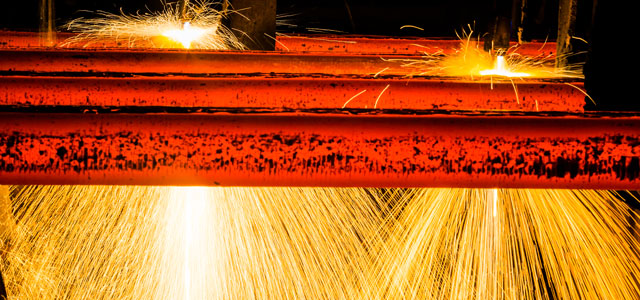Beijing’s push to forge a balance between domestic steel supply and demand bodes well for pricing on potentially undervalued steel stocks.
China’s Baosteel Group is now the second-largest steel company in the world after ArcelorMittal, but it is the undisputed leader in the Middle Kingdom, where roughly half the world’s steel is produced. I recently met with company management for an update on the supply side and its medium-term demand outlook. Growth in Chinese steel production has been declining this year amid Beijing’s efforts to reform the country’s state-owned enterprises (SOE), while output in the rest of the world started accelerating sharply during the first quarter, according to the World Steel Association, just as global economic growth is picking up steam. The effort sets up a nice scenario for steel stocks more generally.
Executives at state-owned Baosteel, whose workforce totals 130,000, report that the government continues pushing to shut down high-cost production capacity. This supply-side reform is slated to finish in 2018 after three years of cuts, following which the focus will turn toward improving the efficiency of heavy industries by forcing consolidation. Beijing wants industry leaders such as Baosteel to lead that process. Baosteel was encouraged to consolidate early in part due to the industry’s very difficult situation. Global steel prices began to stabilize a year ago after a long if volatile ride down from a peak just before the Global Financial Crisis. The price of Chinese hot-rolled band steel is still off 46% from its July 2008 record high.
It's interesting the way Baosteel detailed the consolidation process. It was told to merge with another company and then asked which company it would prefer. In a smart move, it chose Wuhan, China’s second-largest flat steel producer after Baosteel. Flat steel goes into industries that in general are still growing (autos, white goods, etc.) outside shipbuilding. Baosteel now has 60% of the flatsteel market, and flatsteel represents 90% of its production. On the cost side, this merger sounds like a very good deal in terms of procurement and logistics cost synergies, but it will not really be allowed to reduce head count, at least in the short term. One of the really interesting angles is that Wuhan had substantially lower earnings before interest, taxes, depreciation and amortization (EBITDA) per ton than Baosteel for similar products. Baosteel believes that is largely process-driven and addressable.
Management’s comments on Chinese steel demand were equally, if not more, interesting. It anticipates China’s annual steel demand will drop 150 million to 200 million tons over the next 10 years from 700 million today. This forecast includes slow demand growth in flat products and a decline in long products. Baosteel executives would not be surprised to see another round of capacity cuts if demand softens faster than the industry can handle. It sounds as if China will be managing available capacity to target a utilization rate just over 80% or so. If the decline in output falls 15 million to 20 million tons per year, it seems global steel demand should remain flat to slightly up over the period as other emerging markets offset the decline. That is actually a pretty good outcome for steel and iron ore prices, which likely remain on the low end of decent: high enough for low-cost producers to make money but low enough to avoid irrational capacity adds. As core steel stocks trade about 0.6x price/book, neither steel nor iron ore stocks appear priced for this outcome.
Copyright © Thornburg Investment Management















